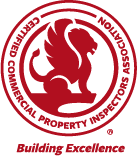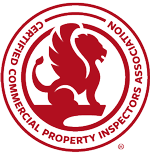The insulation used in low-slope roof assemblies typically falls into one of the four categories:
- rigid board insulation;
- dual-purpose structural deck and insulating planks;
- lightweight insulating concrete (LWIC); or
- sprayed polyurethane foam (SPF).
Rigid Board Insulation
Rigid board insulation is the most common type of insulation used in low-slope commercial roofing. It is made from cellular plastic or fibrous materials and pressed into boards. Rigid board insulation is typically applied to the top surface of the deck, except in the case of a protected membrane roof (PMR), in which case it is applied over the roofing membrane. Typically, foam insulation products use blowing agents to fill the cells in foam. These blowing agents consist of gases that have a higher thermal resistance than air, while fibrous insulation uses trapped air for insulating power. As illustrated in the chart below, foam insulation generally has a higher R-value than fibrous materials.

Rigid board insulation can also be classified as organic – consisting of wood, foamed plastics, and fiberboards; or inorganic – which includes glass fibers, lightweight insulating concrete, perlite, cellular glass, and mineral wool board.
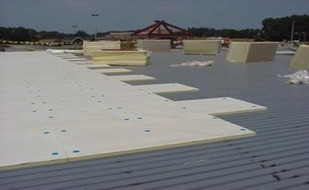
Rigid board insulation mechanically fastened to the metal deck
Foam board insulation comes in four varieties: expanded polystyrene (EPS), extruded polystyrene (XPS), polyisocyanurate (polyiso or ISO), and high-density ISO. Product details for each follow:
1. Expanded polystyrene (EPS), also called beadboard, is the most versatile for its compatibility and has a stable R-value, meaning it doesn’t change over time. EPS can warp, decompose and disintegrate if exposed to hot temperatures, hot asphalt, and solvent-based adhesives. Therefore, a cover board should be installed between the EPS and membrane if it is underneath a black membrane, or requires the application of hot asphalt or solvent-based adhesives. Also, note that EPS will absorb water if exposed to it.
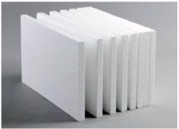
EPS
2. Extruded polystyrene (XPS) is used in protected membrane roof systems (PMR) and vegetative roof systems. This is mostly because it is more resistant to weather than other types of rigid foam board insulation, and thus tends to have a longer life-cycle cost.
Unlike EPS, it exhibits low water permeability and low vapor permeability. To avoid splitting, it should not be used below built-up or a modified bitumen membrane. However, in most applications, a cover board is still required because it provides a surface to adhere the membrane to. As with EPS, it should not be exposed to hot temperatures, hot asphalt, or solvent-based adhesives. This type of insulation is usually pink, blue, yellow, or green. The color identifies the manufacturer.
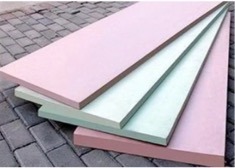
XPS
3. Polyisocyanurate (ISO or polyiso) insulation is usually composed of cream-colored rigid foam that is sandwiched between two face sheets. Technically, ISO is liquid foam sprayed against face sheets, which then expands to form a board.
The various materials used for face sheets include aluminum foil, perlite board, wood fiberglass board, OSB, and fiberglass mats. ISO is often referred to as composite board insulation when the face sheets consists of a rigid board material. Composite board is technically two layers of insulation that are laminated together. However, note that some composite insulation uses ESP, not ISO. The varying face sheets provide different levels of moisture resistance and thermal resistance.
There are restrictions to its installation. Hot bitumen should not be directly applied due to the potential for blistering Additionally, the face sheets can delaminate when compressed from heavy foot traffic. Therefore, cover boards are almost always recommended.
4. High-density ISO has a much higher compressive strength than other foam boards, which can be very beneficial in roof assemblies. Typical composition is a highly compressed core of polyisocyanurate with fiberglass sheets forming the faces. This material can often be used as a cover board, in addition to insulation.
Fibrous insulation consists of wood and vegetable fiber materials, as well as fiberglass. Most organic materials are coated or saturated with asphalt to improve their moisture resistance. Wood fiberboard is often chosen for its impact resistance, durability, and ability to withstand the high temperatures involved with hot bitumen application in built-up roofs, and hot-mop and torched applications.
Cellular glass insulation is comprised of interconnecting closed glass cells containing inert gas. Cellular glass is often chosen for its ability to withstand the heat of applied hot bitumen, as well as its compatibility with the chemical compositions of the other roof system components, and its stable R-value. This type of insulation is vapor-impermeable and does not support the growth of mold, fungi, or micro-organisms. However, it does have cold-weather limitations, and isn’t commonly used in Canada.
Mineral wool insulation, often referred to as stone wool, isn’t commonly used as insulation in low-slope roof assemblies. It’s made by heating rock, slag or glass until molten fibers are spun, then bound together to form a rigid board.
Mineral wool insulation can withstand the high temperatures of both hot bitumen application and heat welders, making it ideal in some situations. Mineral wool is also often used as a cover board in asphaltic roof systems because of its fire resistance and dimensional stability. However, inspectors should look for compression of the insulation from either overdriven mechanical fasteners or heavy foot traffic. Also, note that it is water-repellent but vapor-permeable.
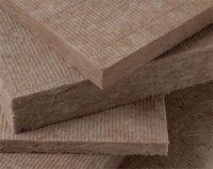
Mineral wool
Perlite is a volcanic glass that expands due to the water content in the ore. The material is often processed with wood fibers and binders to produce rigid boards. Even though the R-value of perlite is low, it is often used as a component in multi-layered systems, or as a cover board in built-up and modified bitumen membrane roof systems. When used as a cover board, it needs a surface coating to prevent excessive absorption of asphalt, as well as blistering. Also, note that perlite will readily absorb water and lose its compressive resistance when exposed to it.

Perlite
Tapered insulation is primarily used to meet slope requirements or to create positive drainage in an existing roof system. It improves roof performance and longevity by draining water properly and in a timely manner. Many building codes contain requirements for minimum roof slope, especially for new construction. From the 2015 International Building Code (IBC) 1507.10.1 Slope:
Built-up roofs shall have a design slope of not less than one-fourth unit vertical in 12 units horizontal (2-percent slope) for drainage, except for coal-tar built-up roofs that shall have a design slope of not less than one-eighth unit vertical in 12 units horizontal (1-percent slope).
Re-roofing usually entails different slope requirements. The IBC’s Section 1507.10.1 exception states:
Roof replacement or roof recover of existing low-slope roof coverings shall not be required to meet the minimum design slope requirement of one-quarter unit vertical in 12 units horizontal (2-percent slope) in Section 1507 for roofs that provide positive drainage.
Many of the types of rigid board insulation discussed above are used to create tapered insulation systems. This includes stone wool, wood fiber, cellular glass, and perlite, and all three forms of rigid foam insulation (XPS, EPS, ISO). Depending on the roof assembly, each type has coinciding benefits and drawbacks.
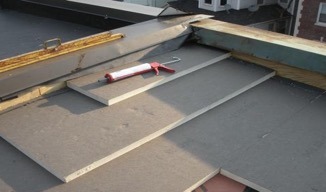
Polyisocyanurate rigid foam board insulation is shown installed in a tapered design over a flat roof.
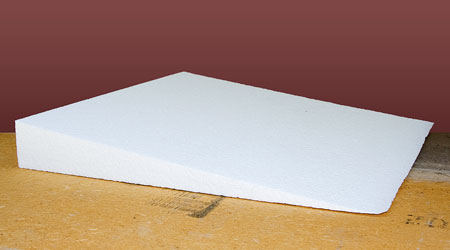
Some tapered insulation is formed with a slope and only needs to be pieced together during the installation process.
Dual-Purpose Structural Deck and Insulating Planks
Dual-purpose structural deck and insulating planks are comprised of cementitious wood fiber planks that are bonded with a foam layer to create a dual-purpose deck with a structural-insulating function. These materials may be seen in older roof assemblies, although less common, they may also be found in modern installations.
Lightweight Insulating Concrete (LWIC)
There are two types of lightweight insulating concrete:
- cellular concrete; and
- expanded aggregate concrete.
Cellular concrete is produced by blending a foaming agent into a cement/water slurry. Expanded aggregate concrete is produced from expanded minerals like perlite or mica (vermiculite), and sometimes polystyrene. These aggregates expand by heat and have a high affinity for water, thus creating a lightweight, low-density concrete.
Both types of LWIC function as a structural insulation and sloped drainage system. Hence, during application, the LWIC can be tapered to provide positive drainage on an otherwise level roof deck. This eliminates the need for costly and oftentimes complicated tapered insulation installations.
LWIC has a higher compressive strength than many of the other types of insulation, and if mixed and installed correctly, it is dimensionally stable. Plus, LWIC is denser than other types of insulation, which provides another benefit. Consider a pan of water on the stove. The added density of the water causes the pan to heat and cool much slower than that of an identical empty pan. In the same manner, the density of concrete insulation is less resistant to heat changes of the membrane from the sun, or a sudden cold rain shower. Thus, LWIC will help stabilize roof temperatures.
Sprayed Polyurethane Foam (SPF)
Sprayed polyurethane foam (SPF) insulation functions as both a structural insulation and a waterproofing system. Technically, it is a combination of chemicals sprayed on a roof deck in layers to create a monolithic surface. Sometimes, SPF is used in combination with a protective roof coating and acts as the primary roof covering.
The foam is extremely lightweight. It can be applied over almost all substrates, even existing roof systems. Plus, SPF easily ties in flashing, penetrations, and parapet walls. Its wind-uplift resistance is directly dependent on the attachment of the substrate to which it is applied.
SPF is sensitive to UV light and, over time, erodes with continued exposure; this is mitigated through the use of a UV protective coating or other covering material. Proper maintenance and re-application of the UV coating prolong the life of the roof. Also note that SPF has temperature and humidity limitations, thus making its application and use difficult in some climate zones.
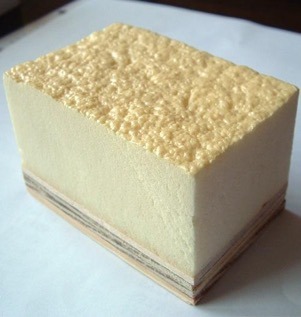
SPF
Cover Boards
A cover board is a relatively thin substrate that’s placed over the primary thermal insulation in a roofing system. The National Roofing Contractors Association (NRCA) endorses the use of cover boards in nearly all low-slope roof assemblies to relieve some of the negative attributes the insulation has, such as moisture absorption, face delamination, blistering, shrinkage, cupping, and edge cavitation. Hence, along with providing a surface to adhere the membrane to, cover boards add a layer of durability and protection to the roof from damage caused by wind, hail, and sometimes fire.
Many of the aforementioned types of insulation may also be used as a cover board, including wood fiber, high-density ISO, perlite, and mineral wool board. Other types of cover boards that may be found within low-slope roofs include:
- Glass-faced gypsum is composed of a gypsum core faced by fiberglass mats. Glass-faced gypsum is an effective cover board due to its adhesive compatibility, moisture resistance, mold resistance, and compressive strength. It is often used as a barrier to provide fire resistance, and it also provides an effective substrate for air and vapor barriers.
- Gypsum fiberboard is a composition cover board with uniform composition in which the fiber reinforces the gypsum. This type of board provides fire resistance, as well as excellent performance against wind uplift and hail. Additionally, it provides an effective moisture barrier.
- Cement board is made up of a core of cement and aggregates with fiberglass facings. Some include fiber reinforcement to the core. It’s often used for its adhesive compatibility and impact resistance. Cement board is also used to provide a fire-resistant barrier over other combustible materials.
- Asphalt core boards consist of rock wool or mineral fiber with a bituminous binder that is sandwiched between fiberglass face sheets. It is most often used as a cover board over insulation, and as a separator in re-cover applications. The asphalt core board is often used because of its compatibility with asphalt coverings and many other system components. It provides impact resistance and fire resistance, as well. It’s often is seen in built-up and modified bitumen roof systems.
The membrane materials, insulation, and roof function determine the kind of cover board installed. For example, a low-slope roof in Florida that is susceptible to high winds and rain would likely use gypsum fiberboard due to its ability to withstand wind uplift, moisture, and mold.
The Takeaway for Commercial Property Inspectors
While thermal insulation and cover boards are often non-visible in the roof system, awareness of the various types and their usage can help to identify areas of weakness and potential failure. Additionally, if you order a roof core sample, the type of insulation will be noted in the report. Understanding how the different types of insulation and foam board interact with each other will help you better position yourself to interpret core sample reports, as well as answer questions your client may have about their low-slope roof.
